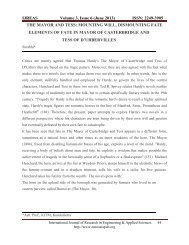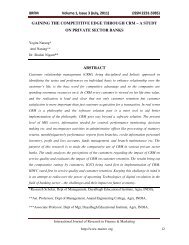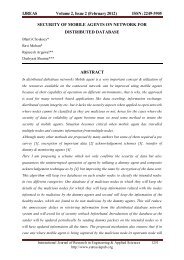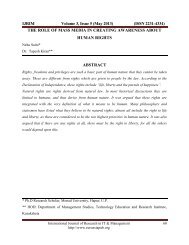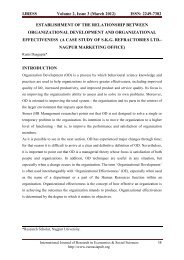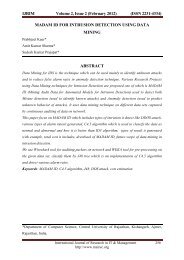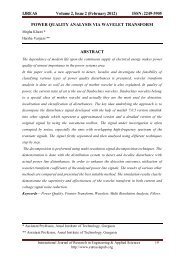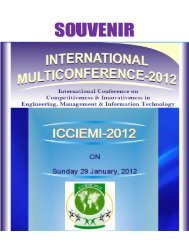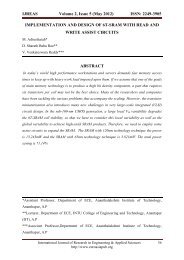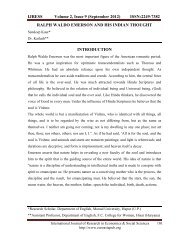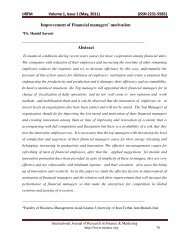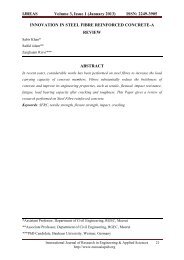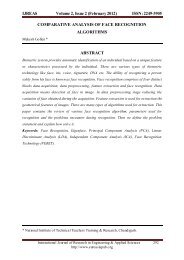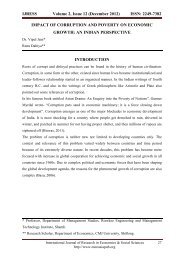mechanical testing of al6061/silicon carbide ... - Euroasiapub.org
mechanical testing of al6061/silicon carbide ... - Euroasiapub.org
mechanical testing of al6061/silicon carbide ... - Euroasiapub.org
You also want an ePaper? Increase the reach of your titles
YUMPU automatically turns print PDFs into web optimized ePapers that Google loves.
IJREAS Volume 2, Issue 2 (February 2012) ISSN: 2249-3905<strong>mechanical</strong> properties <strong>of</strong> the matrix. When designed properly, the new combined materialexhibits better strength than would each individual material.As defined by Jartiz, [7] Composites are multifunctional material systems that providecharacteristics not obtainable from any discrete material. They are cohesive structures madeby physically combining two or more compatible materials, different in composition andcharacteristics and sometimes in form.Kelly [8] very clearly stresses that the composites should not be regarded simple as acombination <strong>of</strong> two materials. In the broader significance; the combination has its owndistinctive properties. In terms <strong>of</strong> strength or resistance to heat or some other desirablequality, it is better than either <strong>of</strong> the components alone or radically different from either <strong>of</strong>them.Berghezan [9] defines as “The composites are compound materials which differ from alloysby the fact that the individual components retain their characteristics but are so incorporatedinto the composite as to take advantage only <strong>of</strong> their attributes and not <strong>of</strong> their shortcomings”,in order to obtain an improved materialVan Suchetclan [10] explains composite materials as heterogeneous materials consisting <strong>of</strong>two or more solid phases, which are in intimate contact with each other on a microscopicscale. They can be also considered as homogeneous materials on a microscopic scale in thesense that any portion <strong>of</strong> it will have the same physical property1.1 Metal Matrix CompositeMetal matrix composites in general, consist <strong>of</strong> at least two components, one is the metalmatrix and the second component is reinforcement. The matrix is defined as a metal in allcases, but a pure metal is rarely used as the matrix. It is generally an alloy. In the productivity<strong>of</strong> the composite the matrix and the reinforcement are mixed together.In recent years, the development <strong>of</strong> metal matrix composite (MMCs) has been receivingworldwide attention on account <strong>of</strong> their superior strength and stiffness in addition to highwear resistance and creep resistance comparison to their corresponding wrought alloys. Theductile matrix permits the blunting <strong>of</strong> cracks and stress concentrations by plastic deformationand provides a material with improved fracture toughness.Cast composites, where the volume and shape <strong>of</strong> phases is governed by phase diagrams, i.e.Cast iron and Aluminium-<strong>silicon</strong> alloys have been produced by foundries for a long time. Themodern composites differ in the sense that any selected volume, shape and size <strong>of</strong>reinforcement can be introduced into the matrix. The modern composites are non-equilibriumInternational Journal <strong>of</strong> Research in Engineering & Applied Sciences 222http://www.euroasiapub.<strong>org</strong>
IJREAS Volume 2, Issue 2 (February 2012) ISSN: 2249-3905mixtures <strong>of</strong> metals and ceramics where there are no thermodynamic restrictions on therelative volume percentages, shapes and size <strong>of</strong> ceramic phases [15].The high toughness and impact strength <strong>of</strong> metals and alloys such as aluminum, titanium,magnesium and nickel-chromium alloys which undergo plastic deformation under impact is<strong>of</strong> interest in many dynamic structural applications <strong>of</strong> metallic composites. These materialshave also been strengthened considerably by means <strong>of</strong> various strengthened principles (likegrain boundary strengthening, cold working, solid solution strengthening, etc.) to improvetheir properties. But these approaches are <strong>of</strong>ten found to affect the toughness and durability atelevated temperatures and/or under dynamic service conditions. One <strong>of</strong> the importantobjectives <strong>of</strong> metal matrix composites, therefore, is to develop a material with a judiciouscombination <strong>of</strong> toughness and stiffness so as to decrease the sensitivity to cracks and flawsand at the same time increase the static and dynamic properties.This necessity eventually leads to the efficient reinforcement <strong>of</strong> metals and metal alloys byuni or multidirectional implantation <strong>of</strong> whiskers or continuous fibers. The reinforcementeffect occurs due to the extraordinary high strength <strong>of</strong> whiskers and fibers with diametersbelow a few micrometers. Thus, the field <strong>of</strong> Metal Matrix Composite (MMCs) began in themid <strong>of</strong> 1960‟s with the realization that whisker reinforced MMCs can be competitive withcontinuous fiber reinforced composites [16], from the standpoint <strong>of</strong> <strong>mechanical</strong> properties[17].The complex fabrication routes, limited fabricability [17, 18] and the small difference inproperty enhancement between whisker and particulate reinforcement [19] and moreover, thehealth hazards associated with handling SiC whiskers [20, 21] have shifted the emphasisrecently more towards particulate or chopped fibers rather than whisker reinforcement <strong>of</strong>metals, especially aluminium, because <strong>of</strong> its light weight and good wettability with <strong>silicon</strong><strong>carbide</strong> [22]. The important shift in metal matrix composite technology began in the mid 80‟swith more and more discontinuous reinforcement taking the place <strong>of</strong> continuousreinforcement such as <strong>carbide</strong>s, nitrides, oxides and elemental materials like carbon and<strong>silicon</strong>While discontinuous whisker reinforced MMCs are still under development for aerospaceapplications, automotive components fabricated from particulate and discontinuous fiberreinforced MMCs, which exhibit essentially isotropic properties, are already in massproduction, led by the introduction <strong>of</strong> diesel piston by Toyota in 1983 followed more recentlyby engine and cylinder blocks from Honda [23,24].International Journal <strong>of</strong> Research in Engineering & Applied Sciences 223http://www.euroasiapub.<strong>org</strong>
IJREAS Volume 2, Issue 2 (February 2012) ISSN: 2249-39051.2 Material Selection (Matrix Material)Lloyd, Riek, enlightens that the matrix alloy should be chosen only after giving carefulconsideration to its chemical compatibility with the reinforcement, to its ability to wet thereinforcement, and to its own characteristics properties and processing behaviour [28, 29].One very crucial issue to consider in selection <strong>of</strong> the matrix alloy composition involves thenatural dichotomy between wettability <strong>of</strong> the reinforcement and excessive reactivity with it[45]. Good load transfer from the matrix to the reinforcement depends on the existence <strong>of</strong> astrongly adherent interface [46, 47]. In turn, a strong interface requires adequate wetting <strong>of</strong>the reinforcement by the matrix. However, the attainments <strong>of</strong> wetting and aggressivereactivity are both favored by strong chemical bonding between the matrix andreinforcement. Adjusting the chemical composition to accomplish this delicate compromise isdifficult as many subtleties are involved.1.3 Why Aluminium Matrix SelectionMMC materials have a combination <strong>of</strong> different, superior properties to an unreinforcedmatrix which are; increased strength, higher elastic modulus, higher service temperature,improved wear resistance, high electrical and thermal conductivity, low coefficient <strong>of</strong> thermalexpansion and high vacuum environmental resistance. These properties can be attained withthe proper choice <strong>of</strong> matrix and reinforcement.Composite materials consist <strong>of</strong> matrix and reinforcement. Its main function is to transfer anddistribute the load to the reinforcement or fibres. This transfer <strong>of</strong> load depends on the bondingwhich depends on the type <strong>of</strong> matrix and reinforcement and the fabrication technique.Lowshenko, Kunter, Jangg, explain certain fundamentals that the matrix can be selected onthe basis <strong>of</strong> oxidation and corrosion resistance or other properties [34]. Generally Al, Ti, Mg,Ni, Cu, Pb, Fe, Ag, Zn, Sn and Si are used as the matrix material, but Al, Ti, Mg are usedwidely.Sarala, Jean, Claude, suggest that now a day‟s researchers all over the world are focusingmainly on Titanium [30] has been used in aero engines mainly for compressor blades anddiscs due to its higher elevated temperature resistance properly.The reason for aluminium being a success over magnesium is said to be mainly due to thedesign flexibility, good wettability and strong bonding at the interface1.4 ReinforcementReinforcement increases the strength, stiffness and the temperature resistance capacity andlowers the density <strong>of</strong> MMC. In order to achieve these properties the selection depends on theInternational Journal <strong>of</strong> Research in Engineering & Applied Sciences 224http://www.euroasiapub.<strong>org</strong>
IJREAS Volume 2, Issue 2 (February 2012) ISSN: 2249-3905type <strong>of</strong> reinforcement, its method <strong>of</strong> production and chemical compatibility with the matrixand the following aspects must be considered while selecting the reinforcement material.Size – diameter and aspect ratio:Shape – Chopped fiber, whisker, spherical or irregular particulate, flake, etc:Surface morphology – smooth or corrugated and rough:Poly – or single crystal:Structural defects – voids, occluded material, second phases:Surface chemistry – e.g. SiO2 or C on SiC or other residual films:Impurities – Si, Na and Ca in sapphire reinforcement;Inherent properties – strength, modulus and density.Even when a specific type has been selected, reinforcement inconsistency will persist becausemany <strong>of</strong> the aspect cited above in addition to contamination from processing equipment andfeedstock may vary greatly [31-33]. Since most ceramics are available as particles, there is awide range <strong>of</strong> potential reinforcements for particlereinforced composites [34-38].Zhang, Perez, gungor et al, explain the use <strong>of</strong> graphite reinforcement in a metal matrix has apotential to create a material with a high thermal conductivity, excellent <strong>mechanical</strong>properties and attractive damping behaviour at elevated temperatures [39]. However, lack <strong>of</strong>wettability between aluminium and the reinforcement, and oxidation <strong>of</strong> the graphite [40] leadto manufacturing difficulties and cavitations <strong>of</strong> the material at high temperatures. Alumina[41] and other oxide particles like TiO2 [42] etc. have been used as the reinforcing particles inAl-matrix. Alumina has received attention as reinforcing phase as it is found to increase thehardness, tensile strength and wear resistance [43] <strong>of</strong> aluminium metal matrix composites.Rohatgi and co-workers [44-46] have studied mica, alumina, <strong>silicon</strong> <strong>carbide</strong>, clay, zircon, andgraphite as reinforcements in the production <strong>of</strong> composites.It is proven that the ceramic particles are effective reinforcement materials in aluminiumalloy to enhance the <strong>mechanical</strong> and other properties [47-49]. The reinforcement in MMCsare usually <strong>of</strong> ceramic materials, these reinforcements can be divided into two major groups,continuous and discontinuous. The MMCs produced by them are called continuously (fibre)reinforced composites and discontinuously reinforcedcomposites. However, they can besubdivided broadly into five major categories: continuous fibres, short fibres (chopped fibres,not necessarily the same length), whiskers, particulate and wire (only for metal). With theexception <strong>of</strong> wires, reinforcements are generally ceramics, typically these ceramics beingoxides, <strong>carbide</strong>s and nitrides. These are used because <strong>of</strong> their combinations <strong>of</strong> high strengthInternational Journal <strong>of</strong> Research in Engineering & Applied Sciences 225http://www.euroasiapub.<strong>org</strong>
IJREAS Volume 2, Issue 2 (February 2012) ISSN: 2249-3905and stiffness at both room and elevated temperatures. Common reinforcement elements areSiC, A1203, TiB2, boron and graphite.2. DESIGN, DEVELOPMENT AND FABRICATION OFCOMPOSITE2.1 Objectives:1. Design and Development <strong>of</strong> Mould2. Fabrication <strong>of</strong> AL6061/SiC MMC3. Experimental Analysis <strong>of</strong> Mechanical Properties <strong>of</strong> MMC on UTM2.2 Design Requirements For Casting Of CompositeThe following principles <strong>of</strong> casting design must be observed to obtain sound castings1. The form <strong>of</strong> casting should allow free withdrawal <strong>of</strong> the pattern from the mould. Thismay be accomplished by allowing a draft on the vertical surfaces <strong>of</strong> casting, the draftvalue being taken as a function <strong>of</strong> the surface height. For internal surfaces, draftvalues should be higher that those <strong>of</strong> external ones.2. The position <strong>of</strong> the surfaces <strong>of</strong> the casting, when the metal is poured, is a major factor.It is necessary to avoid large horizontal surfaces at top <strong>of</strong> the mould, since gasevolved by the metal and in the mould may get trapped and cause cavities andpinholes in the casting.3. The form <strong>of</strong> casting should ensure unimpeded filling <strong>of</strong> the mould with molten metal,both in the direction and velocity <strong>of</strong> flow.4. Other important factors in casting design are shrinkage and its restriction by thefriction <strong>of</strong> the mould and cores, as well as restriction by the difference in the rate <strong>of</strong>cooling <strong>of</strong> different parts <strong>of</strong> the casting.5. The form <strong>of</strong> casting should be such that all the feeding heads, risers, runners, spruesand gates can be easily cut <strong>of</strong>f, all cores knocked out and core irons are removed.6. The size and weight <strong>of</strong> casting, the type <strong>of</strong> alloy employed, and the casting methodshould be taken into account while designing the wall thickness <strong>of</strong> the casting.7. Rib design depends upon overall dimension <strong>of</strong> the casting and their size is in definiterelation with the wall thickness.8. The rate <strong>of</strong> cooling for outside corners is always greater than that <strong>of</strong> inside corners.9. Bosses are provided at places where holes are to be drilled to reinforce the walls <strong>of</strong>the casting.International Journal <strong>of</strong> Research in Engineering & Applied Sciences 226http://www.euroasiapub.<strong>org</strong>
IJREAS Volume 2, Issue 2 (February 2012) ISSN: 2249-39052.3 Design <strong>of</strong> The CompositeGauge LengthOverall LengthFigure 2.3.1 Test SpecimenGauge Diameter: 15mmGauge Length: 75 mmOverall Length: 175 mm2.4 Development and Fabrication <strong>of</strong> Composite2.4.1 Pattern and Mould MakingFigure 3.3.1.1 pattern is produced on lathe Figure 3.3.1.2 Finished Pattern <strong>of</strong> Test BarFirstly pattern is made as per the drawings <strong>of</strong> test bar from wood on lathe machine. Then thepattern is used to produce the moulds in Green sand specifically used for mould making thenadd some binder like molasses and bentonoite to make it little sticky add water as perrequirements and mix it properly manually or electric operated mixerFinally the pattern is placed in mould and sand is poured in the mould to get the requiredshape <strong>of</strong> pattern. Moulds are ready after some preparations figure 3.3.1.3 shows the finishedmoulds.International Journal <strong>of</strong> Research in Engineering & Applied Sciences 227http://www.euroasiapub.<strong>org</strong>
IJREAS Volume 2, Issue 2 (February 2012) ISSN: 2249-3905Figure 3.3.1.3 Final prepared moulds with cavity2.4.2 Chemical Compositon <strong>of</strong> Aluminuim 6061 and Silicon Carbide (SiC)2.4.2.1 Chemical Composition <strong>of</strong> AL 6061Table 3.3.2.1 shows the percentage <strong>of</strong> different elements in AL 6061Weight Al Si Fe Cu Mn Mg Cr Zn Ti Others(%)6061 Bal. 0.40-0.800.70max0.15-0.400.15 0.8-1.20.04-0.350.25max.15max.05maxFigure 3.4.2.1.1 AL 60612.4.2.2 Chemical Compostion <strong>of</strong> SiCTable 3.3.2.2 shows the percentage <strong>of</strong> different elements in SiC (320 grit)Weight (%) SiC SiO2 Si Fe Al C320 grit 98.73 0.48 0.3 0.09 0.1 0.3Figure 3.4.2.2.1 SiC (320 grit)International Journal <strong>of</strong> Research in Engineering & Applied Sciences 228http://www.euroasiapub.<strong>org</strong>
IJREAS Volume 2, Issue 2 (February 2012) ISSN: 2249-39052.4.3 Casting ProcessThe melting was carried in a tilting oil-fired furnace in a range <strong>of</strong> 760 ± 100C. A schematicview <strong>of</strong> the furnace has been shown in Figure 3.4.3.1Figure 2.4.3.1 Stir casting Process [62]1. Motor2. Shaft3. Molten Aluminium4. Thermocouple5. Particle injection chamber6. Insulation hard board7. Furnace8. Graphite crucibleIn the present study, an oil fired tilting furnace has been used. The crucible material wasgraphite. Diesel was used as the fuel. A forced draft fan equipped with 02 H.P 2820-rpmmotor has been used for supplying the required quantity <strong>of</strong> air. Aluminium was preheated upto a temperature <strong>of</strong> 450°C and particles <strong>of</strong> <strong>silicon</strong> <strong>carbide</strong> up to a temperature <strong>of</strong> 110°C incore drying oven. Crucible used for pouring <strong>of</strong> composite slurry in the mold was also heatedup to 760°C.In the present study, a new stir caster was developed to fabricate MMC. It has been used toobtain an output <strong>of</strong> 600 rpm [50]. The stir caster was mounted on the furnace with the help <strong>of</strong>International Journal <strong>of</strong> Research in Engineering & Applied Sciences 229http://www.euroasiapub.<strong>org</strong>
IJREAS Volume 2, Issue 2 (February 2012) ISSN: 2249-3905four legs. Mild steel was chosen as stirrer and impeller material. During experimental work, afour bladed 45° angled stirrer was chosen. The stirrer position should be such that 35% <strong>of</strong>material should be below the stirrer and 65% <strong>of</strong> material should be above the stirrer [51]First <strong>of</strong> all stirring system has been developed by coupling motor with gearbox and a mildsteel stirrer. All the melting was carried out in a graphite crucible in an oil-fired furnace.Aluminium were preheated at 450°C for 3 to 4 hours before melting and mixing the SiCparticles were preheated at 110°C for 1 to 3 hours to make their surfaces oxidized.The furnace temperature was first raised above the liquidus to melt the alloy scrapscompletely and was then cooled down just below the liquidus to keep the slurry in a semisolidstate. At this stage the preheated SiC particles were added and mixed manually. Manualmixing was used because it was very difficult to mix using automatic device when the alloywas in a semi-solid state.After sufficient manual mixing was done, the composite slurry was reheated to a fully liquidstate and then automatic <strong>mechanical</strong> mixing was carried out for about 10 minutes at a normalstirring rate <strong>of</strong> 600 rpm [50]. In the final mixing process, the furnace temperature wascontrolled within 760° ± 100°C.3. EXPERIMENTAL PLANNING3.1 Tensile TestAlthough tensile <strong>testing</strong> is not recommended in examining the fracture behavior <strong>of</strong> SiCreinforced aluminum composite, tensile tests were performed to get stress – strain graphs, t<strong>of</strong>ind out Young‟s Modulus and ultimate tensile strength values. But unfortunately, specimensfractured in the early stages <strong>of</strong> tensile tests and lower strength values were obtained. Almostall specimens broken from the curved parts. Agglomeration <strong>of</strong> <strong>silicon</strong> <strong>carbide</strong> particulateswas observed in some <strong>of</strong> the tensile test specimensAPPARATUS: Universal Testing Machines, Dumbbell Test Specimen, Micro Meter 0-25mm, Vernier Caliper 0-25cm.SPECIFICATION: Maximum capacity 200kNNumber <strong>of</strong> Graduation 500Range0-200kN, minimum graduation 0.4kNRange0-100kN, minimum graduation 0.2kNRange0-50kN, minimum graduation 0.1kNRange0-20kN, minimum graduation 0.04kNWorking hydraulically operated and driving is pr<strong>of</strong>ound by the help <strong>of</strong> electric motor.International Journal <strong>of</strong> Research in Engineering & Applied Sciences 230http://www.euroasiapub.<strong>org</strong>
IJREAS Volume 2, Issue 2 (February 2012) ISSN: 2249-3905DESCRIPTION: Universal <strong>testing</strong> machine serves for conducting tests in tension,compression, bending, shearing and flexural tests can be performed on these machines withsuitable grips and fixtures for metal and other materials.These machines re designed for <strong>testing</strong> various materials like rubber, plastics, cables, leather,paper, ploy wood and metals. These machines are powder coated for elegant look and eachcritical component is plated for rust prevention and durability.The test machines are hydraulically operated and driving is performed by the help <strong>of</strong> electricmotor. The machines are equipped with pendulum dynamometer, recording device forregistering load deformation diagram.SALIENT FEATURES:High accuracy <strong>of</strong> (+/- 1%) as per IS1828Four measuring ranges for accurate <strong>testing</strong>Easy to operate and less maintainAttachment for conducting compression, bending, shear testsDifferent range <strong>of</strong> grips for various materials and shapesIn corporate with requisite safety devicesVariable speed to suit various materialsHigh reading accuracy due to large size design <strong>of</strong> dialEnables <strong>testing</strong> <strong>of</strong> standard specimens as well as structuresTHEORY: A tensile test also known as tension test is probably the most fundamental type<strong>of</strong> <strong>mechanical</strong> test you can perform on material. Tensile test are simple, relatively inexpensive and fully standardized. As the material is pulled, you will find its strength alongwith how much it will elongate.PROCEDURE:1. Select the proper jaw, insert and complete the upper and lower chuck assemblies.2. Take necessary reading for diameter and gauge length <strong>of</strong> the test piece.3. Then operate the upper cross head grip operation handle and grip fully the upper end<strong>of</strong> the test piece.4. The left valve in fully closed position and right valve in normal open position.5. Open the right side valve and close it after the lower table is slightly lifted. Nowadjust the lower pointer to zero with the zero adjusting knob.6. Then turn the right control valve slowly to open position until you get desired loadingrate.International Journal <strong>of</strong> Research in Engineering & Applied Sciences 231http://www.euroasiapub.<strong>org</strong>
IJREAS Volume 2, Issue 2 (February 2012) ISSN: 2249-39057. Operate the lower grip operation handle and lift the lower cross head up and grip fullyhe lower part <strong>of</strong> the specimen. Then lock the jaws in this position by jaw lockinghandle.8. When the specimen under load, unclamp the locking handle.9. Notice the occurrence <strong>of</strong> yield point by indication <strong>of</strong> load pointer.10. When the rest piece is broken, close the right control valve, and take out the brokentest piece. Then open the left control valve to take the piston down.11. Note down the maximum load, pointer shows the maximum capacity <strong>of</strong> the specimen.OBSERVATIONS:Table 3.3.3S.No. Material <strong>of</strong>Test piece1. AL6061/SiC(2.5p)2. AL6061/SiC(5.0p)3. AL6061/SiC(10.0p)CALCULATIONS:GaugeDiameter <strong>of</strong>CrosssectionalLoad atyieldUltimateload, NTest specimen,mmarea,mm 2point, NGauge IncreaseLength, inmm length,mm15 176.625 1800 7000 75 8415 176.625 2900 9200 75 8915 176.625 3500 12200 75 93Tensile strength (N/mm 2 ): Ultimate Load (N) / Cross Sectional Area in mm 2Yield Stress (N/mm 2 ): Yield Load (N) / Cross Sectional Area in mm 2Elongation (%): {(Increase in length – Original length) x 100} / Original length.Table 3.3.4S.No. Material <strong>of</strong> Test Piece Tensile Yield Stress Elongation (%)Strength,(N/mm 2 )(N/mm 2 )1. Al6061/SiC(2.5p) 39.63 10.19 11.252. Al6061/SiC(5.0p) 52.08 16.41 17.503. Al6061/SiC(10.0p) 69.07 19.81 22.50PRECAUTIONS:1. Apply the load in a uniform rate without any jerk.International Journal <strong>of</strong> Research in Engineering & Applied Sciences 232http://www.euroasiapub.<strong>org</strong>
IJREAS Volume 2, Issue 2 (February 2012) ISSN: 2249-3905In Graph 4.2.2 their is increase in value <strong>of</strong> yield stress <strong>of</strong> composite as the percentage <strong>of</strong> SiCis increased. The maximum value <strong>of</strong> yiels stress is obtained at 10% <strong>of</strong> SiC addition and valueis 19.81 N/mm 2 and minimum value is 10.19 N/mm 2 obtained at 2.5% <strong>of</strong> SiC addition in AL6061.Elongation v/s SiC %3210 5 10 15 20 251 2 3Series2 11.25 17.5 22.5Series1 2.5 5 10Graph 4.1.3 shows the variation <strong>of</strong> the Elongation (series 2) with increase in SiC (series1) at various percentage.In Graph 4.1.3 their is increase in elongation from 11.25% to 22.5% as the addition <strong>of</strong> SiC isincreased from 2.5% to 10% respectively.Figure 4.1.1a Al6061/SiC composite Test BarsFigure 4.1.1b Test bar under Tensile Test1. The results <strong>of</strong> study suggest that with increase in composition <strong>of</strong> SiC, an increase intensile strength, yield stress and elongation have been observed.2. The maximum value has been obtained at 10% weight fraction <strong>of</strong> 320 grit size SiCparticles. Maximum tensile strength = 69.07 N/mm 2 , Maximum yield stress = 19.81N.mm 2 , and Maximum elongation = 22.50 %International Journal <strong>of</strong> Research in Engineering & Applied Sciences 234http://www.euroasiapub.<strong>org</strong>
IJREAS Volume 2, Issue 2 (February 2012) ISSN: 2249-3905Figure 4.1.1c Test bar under Tensile TestFigure 4.1.1d Readings noted during TestFigure 4.1.1e Test bar after Tensile Test3. Homogenous dispersion <strong>of</strong> SiC particles in the Al matrix shows an increasing trend inthe samples prepared by stir casting techniqueREFERENCES1. A.K.Dhingra, (1986) “metal replacement by composite”, JOM, Vol 38 (03), p. 17.2. K.Upadhya, (1992) “composite materials for aerospace applications, developments inceramic and metal matrix composites”, Kamaleshwar Upadhya, warrendale, PA: TMSpublications, pp. 3-24.3. Greg Fisher, (1993) “Composite: Engineering the ultimate material”, Am. Ceram.Soc, Bull. Vol. 63 (2), pp. 360-364.4. T.G.Nieh, K.R. Forbes, T.C. Chou and J. Wadsworth, (1990) “Microstructure anddeformation properties <strong>of</strong> an Al2O3-Ni3Al composite from room temp to 1400°C”,High performance Composites for the 1990‟s Eds. S. K. Das, C. P. Ballard and F.Marikar, TMS-New Jersey, pp 85-96.5. T. W. Clyne, (2000) “An Introductory Overview <strong>of</strong> MMC System, Types andDevelopments, in Comprehensive Composite Materials,” Vol-3; Metal MatrixComposites, T. W. Clyne (ed), Elsevier, pp.1-26.6. L.M.Manocha & A.R. Bunsell, (1980) “Advances in composite materials”, PergamonPress, Oxford, , Vol.2, p 1233-1240.International Journal <strong>of</strong> Research in Engineering & Applied Sciences 235http://www.euroasiapub.<strong>org</strong>
IJREAS Volume 2, Issue 2 (February 2012) ISSN: 2249-39057. Jartiz, A.E., Design 1965, pp. 18.8. Kelly, A. (1967) Sci. American 217, (B), 161.9. Berghezan, A. Nucleus, 8(5), 1966, (Nucleus A. Editeur, 1, rhe, Chalgrin, Paris, 16(e).10. Van suchetclan, Philips (1972), Res. Repts. Vol. 27., pp. 28.11. B.D.Agarwal and L.J.Broutman, (1980), “Analysis and performance <strong>of</strong> fibercomposites” John Wiley & Sons, New York, pp.3-12.12. J.O.Outwater, (1956), “The Mechanics <strong>of</strong> Plastics Reinforcement Tension”, Mod.Plast: March.13. R.Wetter, (1970), “Kunstst<strong>of</strong>fe in der Luft-und Raumfahrt”, Kunstst<strong>of</strong>fe, 60, Heft 1014. P.H.Selden, (1967), “Glasfaserverstarkte Kunstst<strong>of</strong>fe”, SpringerVerlag,.15. Pradeep Rohatgi, IUNIDO‟s State-<strong>of</strong>-the-art series: (1990), “Advances in MaterialsTechnology: MONITOR”, Compiled by the Industrial Technology DevelopmentDivision Department <strong>of</strong> Industrial Promotion, Vienna, Austria, No.17, Feb.16. N.J. Parrat, (1964), “Reinforcement effects <strong>of</strong> Silicon Nitride in Silver and ResinMatrices”, Powder Metallurgy, Vol. 7(14), pp 152-167.17. R. R. Irving, (1986), “Composites Go After Commercial Markets”, Iron Age,Sept.5th, pp 35 38.18. A. Mortensen, J.A. Cornie and M. C. Flemings, (1988), “Solidification processing <strong>of</strong>Metal Matrix Composites”, JOM, Vol. 40(2), p 12-19.19. D.L. McDanels and C.A. H<strong>of</strong>fman, (19840, “Microstructure and orientation effectson properties <strong>of</strong> discontinuous Silicon Carbide/ Aluminum Composites” NASA Tech.Pap. 2303, Cleveland, OH, , pp 1-29.20. J.L. Cook and Walter R. Mohan, (1987) “Whisker-reinforced MMCs‟ Metal, Carbon /Graphite and Ceramic Matrix Composites”, pp 896-902.21. Milton W. Toaz, “Discontinuous Ceramic Fiber MMCs” International Encyclopedia<strong>of</strong> Composites, Vol. 3. ed. Stuart M. Lee, VCH Publishers, NY, p. 903-910.22. D. L. McDanels and A. R. Signorelli, (1983), “Evaluation <strong>of</strong> low cost AluminumComposites for Aircraft engine Structural Applications”, NASA Tech. Memo. No.83357, Washington, DC.23. William J. Baxter, (1992), “The strength <strong>of</strong> MMCs Reinforced with Randomlyoriented Discontinuous Fibers”, Mett. Tran. Vol. 23A, Nov., pp 3045-3053.24. David M. Schuster, Michael D. Skibo and Williams R. Hoover, (1989) “Productionand Semi-Fabrication <strong>of</strong> an Aluminum Composite Material”, Light Metal Age, Feb.,pp 15-19.International Journal <strong>of</strong> Research in Engineering & Applied Sciences 236http://www.euroasiapub.<strong>org</strong>
IJREAS Volume 2, Issue 2 (February 2012) ISSN: 2249-390537. A. K. Kuruvilla, V.V. Bhanuprasad, K. S. Prasad and Y.R. Mahajan, (1989) “Effect <strong>of</strong>different reinforcements on Composite-strengthening in aluminium”, Bull. Mater.Sci., Vol. 12(5), , pp 495-505.38. R.L. Mehan, (1968) “Fabrication and Evaluation <strong>of</strong> Sapphire Reinforced AlComposites”, Metal Matrix Composites, ASTM-STP, Vol. 438, pp 29-58.39. J. Zhang, R.J. Perez, M. N. Gungor and E.J.Lavernia, (1992) “DampingCharacteristics <strong>of</strong> Graphite Particulate Reinforced Aluminium Composites”,Developments in Ceramics and Metal Matrix Composites. Kamleshwar Upadhya, ed.,Warrendale, PA: TMS Publication, pp 203-217.40. Thomas D. Nixon and James D.Cawley, (1992) “Oxidation Inhibition Mechanisms incoated Carbon-Carbon Composites”, J. Am. Ceram. Soc., Vol. 75(3), pp 703-70841. M.V Ravichandran. R.Krishna Prasad and E.S.Dwarakadasa, J. Mater. Sci. Letts; Vol-11, 1992, p.452.42. P.K.Balasubramanian, P.Srinivasa Rao, et.al. J.Mater.Sci.Letts., Vol-8, 1989, p.799.43. J.Singh, S.K.Goel, V.N.S.Mathur and M.L.Kapoor; (1991)J.Mater. Sci., Vol-26..44. Deonath and P.K.Rohatgi, (1980) „Fluidity <strong>of</strong> Mica Particle Dispersed AluminumAlloy: J. Mat. Sci., Vol. 15,. pp 2777-2784.45. Deonath, R.T.Bhat and P.K.Rohatgi, (1980) “Preparation <strong>of</strong> Cast ALLOY-MicaParticle Composites”: J. Mater. Sci., Vol. 15, pp.1241-1251.46. M.K.Surappa and P.K.Rohatgi, (1981) „Preparation and Properties <strong>of</strong> Cast AluminumCeramic Particle Composites, „J.Mat. Sci., Vol.16, pp.983-993.47. A.Banerji, M.K.Surappa and P.K.Rohargi, (1983) “Cast Aluminum Alloys ContainingDispersions <strong>of</strong> Zircon Particle”, „Metall. Trans. Vol. 14B, PP.273-283.48. M.Taya and R.J.Arsenault, (1989), “Metal Matrix Composites–Thermo <strong>mechanical</strong>behaviour” New York, Pergmon Press, p -238-243.49. K.K.Chawla, (1987), Composite materials–Science and Engineering, New YorkSpringer Verlag, pp. 67-72.50. Balasivanandha, S., Kaarunamoorthy, L., Kaithiresan, S. and Mohan, B. (2006),“Influence <strong>of</strong> stirring speed and stirring time on distribution <strong>of</strong> particles in cast metalmatrix composite”, Journal <strong>of</strong> Material Processing Technology, Vol. 171, pp. 268-273.51. Hashim, J., Looney, L. and Hashmi, M.S.J. (2001), “The wettability <strong>of</strong> SiC particles bymolten aluminum alloy”, Journal <strong>of</strong> Materials Processing Technology, Vol. 119 (1-3), pp.324-328.International Journal <strong>of</strong> Research in Engineering & Applied Sciences 238http://www.euroasiapub.<strong>org</strong>


